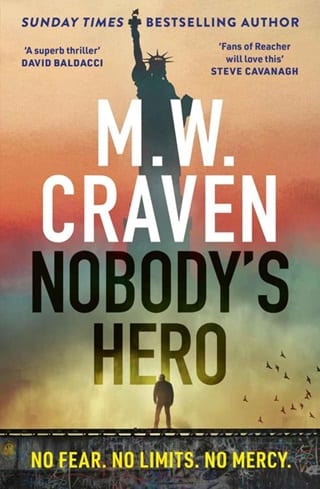Chapter 127
Chapter 127
Koenig had once been involved in the hunt for an embittered, mid-level nuclear scientist called Oscar Sands. Sands had somehow been included on an interdepartmental email chain, one of those rambling ones where the most recent email had little to do with the originating email. Sands had joined the chain near the end. He’d been asked for his input on something Koenig hadn’t understood. Unfortunately for the person who’d cc’d him, the originating email was way above Sands’s security level. And Sands wasn’t the kind of guy to ignore that. Sands was the kind of guy who would print out the entire email chain, then go shopping for a buyer.
He was a clumsy criminal, though. Hadn’t realised that all departmental printers kept a record of who printed what and when. A warrant was issued for his arrest, and because it was time sensitive, Koenig’s team got the call.
So, Koenig knew a bit about how nuclear power plants worked. He knew uranium was processed into small pellets, which are then stacked together in sealed metal tubes called fuel rods. A bunch of these rods are bundled together to form a fuel assembly. Individually, fuel assemblies aren’t enough to sustain a nuclear reaction, but when they are lowered into the reactor core with around two hundred others, fission takes place. This causes heat. This heat turns water into steam, which nuclear power plants use to spin the turbines that produce carbon-free electricity. After eighteen months, the fuel assemblies no longer produce enough heat to spin the turbines. They are then classified as ‘spent’. Although no longer useful in providing electricity, spent assemblies keep producing heat for decades. They are kept in cooling ponds until they are safe enough for dry storage vaults – usually a geologically stable bunker miles from populated areas – where they remain dangerously radioactive for ten thousand years.
Spent nuclear fuel rods are extremely well guarded. They are all accounted for. If one goes missing, it’s a huge deal. In 2023 an eight-millimetre-long radioactive capsule fell off a truck in the Australian outback. It sparked a national alert and a search involving thousands of people. That’s how seriously missing nuclear material is taken.
Yet Tas had gotten hold of some complete rods anyway. They were probably fitted to the inside of the boat’s hull. Along with gallons and gallons of coolant. It was why the boat was sitting so low in the water. It hardly seemed possible. Smerconish would have known if any were missing. He would have been briefed. Not knowing about missing fuel rods didn’t seem like a ball Smerconish would drop.
Even so, having a bunch of spent fuel rods wasn’t enough. Tas couldn’t just dump them into Lake Mead. That wouldn’t work. It wouldn’t achieve the objectives of the Acacia Avenue Protocol. The rods would leak too slowly. They’d be recovered before any lasting damage had been done. Tas needed to blow them up. To turn a few fuel rods into ten million pieces of radioactive hell. Leaching foul poison into Lake Mead for the next ten thousand years. But Tas couldn’t do that himself. He couldn’t risk bringing his own explosives on board. The heat of the fuel rods might set off the detonators prematurely.
Which was where Smerconish came in. Because blowing things into ten million pieces was what the US Air Force did best. It was their raison d’être. So when one of Smerconish’s F-35s fired an air-to-surface missile into Tas’s boat, the water for millions of people would immediately be rendered undrinkable. It couldn’t be fixed. It couldn’t be neutralised. ‘Lake Mead’ would become synonymous with ‘Chernobyl’. An updated byword for nuclear disaster.
Koenig thought he could detect Margaret’s hand in this last part. She’d have wanted the US military to be the author of America’s demise. A final screw-you to the institution that had let down her daughter.
But then he thought about Carlyle. Considered how thorough she was and how adamant she’d been that a significant body of water couldn’t be rendered toxic. Not for any length of time. Koenig doubted Carlyle would have overlooked spent nuclear fuel if a small amount could get the job done. That didn’t seem plausible.
Again, Koenig felt he’d been put in check. That there was still something he wasn’t seeing.
He shook his head and took a flier. ‘You don’t have enough of the nasty stuff, Jakob. Nowhere near enough. If you could get enough on a boat this size, Bess Carlyle would have thought of it.’
‘You’re quite right, Mr Koenig,’ Tas said. ‘There isn’t enough spent fuel on this boat to cause long-lasting damage.’ He smiled. Humouring him.
‘But?’
‘Do you know what the fastest growing branch of anthropology is?’
Koenig didn’t. He said as much.
‘Margaret did,’ Tas said. ‘She was a cultural anthropologist. And although she was almost retired, she kept up to date with all new developments.’
‘Enlighten me,’ Koenig said.
‘Digital anthropology.’
And there it was. The vital ingredient Carlyle hadn’t considered. She believed destroying a body of water was impossible. And she was right. It was impossible. But she was also wrong. She hadn’t made a mistake. The vital ingredient hadn’t existed then. Not in the toxic form it existed now.
Social media.
And social media had been weaponised. It could move mountains. Fewer and fewer Americans were getting their news from traditional outlets these days. They were getting it from TikTok and Instagram. From Facebook and the artist formerly known as Twitter. From YouTube. A hundred other platforms. And the phenomenon of fake news had exploded after Carlyle’s think tank. They hadn’t considered it because it hadn’t existed. Not like it did now.
Tas dumping spent fuel rods in Lake Mead would cause a mid-level toxic event. Big, not huge. Disastrous but manageable. Government advice would be to stay calm. To use bottled water until told otherwise. But what about when the Russians got involved? The Chinese and the Iranians. The North Koreans. They had whole departments dedicated to sowing discord in the American population. Bot factories. Dividing opinions and people. What would happen when they got going on social media? And in the comments section of websites. Posting links to ‘real’ science. Do your own research, people! Drip-feeding their audience disinformation. It’s in the groundwater, people! If Margaret had known what she was doing, and Koenig had to accept she had, she’d have held back some radioactive material. And each time the government said the water was clean, another dirty sample would be found. It’s a cover-up, people!
No one cares which cow started the stampede.
Within days people would begin fleeing the immediate area. And the ones who didn’t? The ones who trusted the government? Sheeple! Within weeks, Los Angeles and Las Vegas and San Diego and a dozen other towns that relied on Lake Mead for drinking water would empty. Vast numbers of the West Coast population would migrate east and north. To towns and cities ill-equipped to deal with them. Just like it had after Partition, the infrastructure would collapse.
Chaos.
The richest country on Earth turned on its ass.
 Fullepub
Fullepub 



